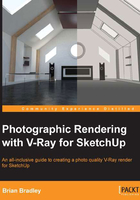
What this book covers
Chapter 1, Diving Straight into Photographic Rendering, gets us nicely up and running with V-Ray in SketchUp as it fast tracks us through with the use of many key areas in the render engine, all of which need to be utilized by an artist if they want to produce photographic renders using V-Ray.
Chapter 2, Lighting an Interior Daytime Scene, gives us a thorough grounding in lighting a daytime interior scene in SketchUp. A variety of potential lighting approaches introduce us to a wide range of V-Ray light types available for use in a similar scenario. As we explore these approaches, we will also see the pros and cons that go along with using them.
Chapter 3, Lighting an Interior Nighttime Scene Using IES Lights, naturally presents a different set of lighting challenges to us and thus, introduces us to some more specialized tools such as the IES light type, which has been provided to help us recreate the energy output and complex light throw patterns that often come from man-made light fixtures.
Chapter 4, Lighting an Exterior Daylight Scene, revisits the V-Ray Sun & Sky tools that we touched on in Chapter 1, Diving Straight into Photographic Rendering. Here though we take a much more detailed look at how these procedural lighting tools can be used to effectively recreate very natural-looking daytime lighting conditions.
Chapter 5, Understanding the Principles of Light Behavior, introduces us to some key lighting concepts and theory that in and of themselves are not essential to our being able to use the V-Ray render engine, but will certainly help us understand how we can use light in a more realistic manner and thus, produce increasingly photographic-looking renders.
Chapter 6, Creating Believable Materials, moves us into the area of realistic material creation. In order to produce photographic-looking renders, the materials we apply to the geometry in our scenes will need to both look and react to light in the same manner as their real-world counterparts. In this chapter, we explore the creation of a number of common architectural material types as well as consider a number of possible workflow options for ourselves.
Chapter 7, Important Materials Theory, reminds us that as with lighting, understanding how and why materials behave the way they do can, go a long way towards helping us make informed texturing choices that will contribute greatly to the quality of the finished piece. In this chapter, we explore the how and why regarding a number of important material concepts such as reflectance and transmittance, all of which ultimately needs to combine in order to create realistic looking surfaces for our objects.
Chapter 8, Composition and Cameras, covers some extremely important and yet often overlooked aspects of photographic rendering in the form of composition and framing. Closely linked to these subjects are the choices that need to be made in our camera settings, such as aspect ratio, focal length, and output resolution, all of which can and will significantly affect the photographic quality of our final renders.
Chapter 9, Quality Control, introduces us to the lighting, global illumination, image sampling, and material controls that can help us produce clean, high quality photographic-looking output. The goal in this chapter is to show how (as much as possible) we are able to balance high quality output with the overall render time taken to produce it. High quality and high resolution rendering will always be a time consuming process, but we can avoid adding unnecessary time burdens to the process.
Chapter 10, Adding Photographic Touches in Post-production, takes us away from the 3D world of SketchUp and V-Ray and into the 2D world of post production. Here we use Adobe After Effects but of course, any good image editing or compositing application should suffice. The aim is to add a few extra photographic touches to the image rendered out of V-Ray, in order to add a final bit of polish to the good work that we have already done there.